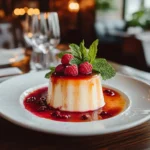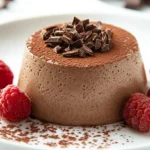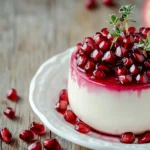Few desserts capture the elegance and simplicity of Italian cuisine, like Panna Cotta. This classic dish, whose name translates to “cooked cream,” is a smooth, creamy delight that melts in your mouth. Whether you’re hosting a dinner party or craving something sweet on a quiet evening, this recipe will make you feel like you’re dining in the heart of Italy. Best of all, it’s easier to make than you think—trust me, you’re going to love this. If you’re curious about other elegant desserts like Bavarois, check out this guide to Bavarois and Panna Cotta.
How do you make Gordon Ramsay panna cotta?
To make Gordon Ramsay’s panna cotta, simmer cream with sugar and vanilla, mix in gelatin, pour into molds, chill until set, and serve with a berry sauce!

Why I Love This Recipe for Italian Panna Cotta
For special events, Panna Cotta has always been my first choice for dessert. It tastes like a hug in treat form, with its smooth, silky texture and light vanilla or citrus flavors. Besides that, it’s very flexible. It tastes great whether you put fresh berries, toffee, or chocolate sauce on top of it. This is a game-changer for people who are scared of fancy desserts.
If you’re like me and enjoy recipes that balance simplicity with elegance, you’ll appreciate this Italian Panna Cotta recipe. It genuinely tastes like something you’d order in a high-end Italian restaurant. And I’m not kidding—this recipe might just become your new favorite dessert.
What is the difference between bavarois and panna cotta?
The key difference is that bavarois is a mousse-like dessert made with whipped cream and egg yolks, while panna cotta is a creamy, gelatin-set dessert without eggs!

Key Ingredients for Italian Panna Cotta
The cool thing about this treat is that it only needs a few simple things. Let us break them down:
- Heavy Cream is the main attraction! Choose full-fat cream to get that smooth, rich feel.
- Sugar: It adds just the right amount of sweetness without making the taste too strong.
- Vanilla Bean or Extract: Vanilla brings out the creaminess of the cream. If you really want to go the extra mile, use a whole vanilla bean for a more unique look and taste.
- Gelatin: This is what gives Panna Cotta its signature set. Use unflavored gelatin for the best results.
- Milk: A splash of milk helps balance the creaminess, ensuring it’s not too heavy.
Substitutions You Can Try
- Out of heavy cream? Coconut cream works surprisingly well and adds a tropical twist.
- Want it dairy-free? Almond or oat milk paired with a plant-based gelatin substitute is a great option.
- No vanilla? A hint of almond extract or orange zest can create an entirely new flavor profile.
How to Make Italian Panna Cotta
Creating this creamy masterpiece is surprisingly simple. Just follow these steps:
Ingredients:
- 2 cups heavy cream
- 1/4 cup sugar
- 1 teaspoon vanilla extract (or the seeds of 1 vanilla bean)
- 1/2 cup whole milk
- 1 packet of unflavored gelatin (about 2 1/2 teaspoons)
Step-by-Step Instructions:
- Bloom the Gelatin:
- Spoon gelatin over the milk in a small bowl. Let it soften for five to ten minutes. This next step is crucial for achieving the ideal texture.
- Warm the Cream Mixture:
- Whisk the heavy cream, sugar, and vanilla in a medium saucepan. Cook over medium-low, stirring very gently, until the sugar melts. Do not boil; it should be just warm and steamy.
- Incorporate the gelatin:
- Once the cream mixture is hot, please remove it from the heat and stir in the gelatin mixture. Whisk until completely dissolved.
- Pour and chill:
- Divide the mixture into individual ramekins or glasses. Cover each with plastic wrap and refrigerate for at least 4 hours or overnight for the best results.
- Serve:
- Dip the ramekins in boiling water for a few seconds to unmold the Panna Cotta onto plates. For a sophisticated presentation, serve them straight in the glasses.
Pro Tips:
- Pour the contents into ramekins using a fine-mesh strainer to capture any undissolved gelatin or vanilla bean fragments.
- Present alongside berry coulis, caramel sauce, or even a scattering of crushed pistachios.
Common Mistakes to Avoid:
- Overheating the cream: This can cause the mixture to curdle. Keep the heat low!
- Skipping the gelatin bloom: Adding gelatin directly to a hot liquid prevents it from dissolving properly.
Chef’s Tips & Variations for Italian Panna Cotta
Making Italian Panna Cotta is already simple, but with a few tweaks and tips, you can elevate this dessert to new heights. Here are some of my favorite tricks and creative variations:
Tips for Perfect Texture and Flavor
- Achieving the Right Texture: Panna Cotta should have a soft, wobbly jiggle—firm enough to hold its shape but creamy when eaten. If it feels rubbery, reduce the amount of gelatin slightly in your next batch.
- Infuse Flavors: Steep herbs like rosemary or basil in the cream mixture for a savory twist, or use spices like cinnamon or cardamom for a warm, aromatic variation. Strain them out before adding the gelatin.
- Room-temperature ingredients: Using milk and cream that aren’t straight from the fridge helps the gelatin dissolve evenly.

Delicious Variations to Try
- Chocolate Panna Cotta: Replace half the heavy cream with melted dark chocolate for a rich, decadent version.
- Coconut panna cotta: Swap the heavy cream for coconut cream and add a touch of lime zest for a tropical vibe.
- Coffee-Infused: Stir in a teaspoon of instant espresso powder while heating the cream for a bold, coffee-flavored dessert.
- Fruit Layered: Pour a thin layer of fruit puree (like mango or raspberry) over the set Panna Cotta for a pop of color and flavor.
Trust me, once you start experimenting, you might make it twice in one week!

Storing, Reheating & Freezing Italian Panna Cotta
One of the best things about Panna Cotta is how well it stores, making it a perfect make-ahead dessert. Here’s how to keep it fresh:
Storing in the Fridge
- Store individual servings covered with plastic wrap or in airtight containers to prevent them from absorbing fridge odors. They’ll stay fresh for up to four days.
Reheating? Not Necessary!
- Panna Cotta is best served cold, so there’s no need to reheat. For the best flavor, take it out of the fridge about 10–15 minutes before serving.
Can You Freeze Panna Cotta?
- Yes! Panna Cotta freezes surprisingly well. To freeze, place the ramekins in a freezer-safe bag or container for up to 2 months.
- Thawing Tip: Let it thaw in the fridge overnight before serving. While the texture might be slightly softer after freezing, it’ll still taste amazing.
Frequently Asked Questions
What does Panna Cotta taste like?
Rich and velvety in taste, Panna Cotta features subdued vanilla undertones. Its silky and smooth texture makes it the ideal canvas for many toppings and infusions.
Can I make Panna Cotta vegan?
True! Replace heavy cream with vegan substitutes such as almond milk or coconut cream. For gelatin, use agar-agar, a vegan-friendly thickener. Keep in mind that agar sets more firmly, so you might need to adjust the quantity.
Why is my Panna Cotta not setting?
If your Panna Cotta didn’t set, the gelatin might not have appropriately dissolved or bloomed before adding to the cream mixture. Be sure to follow the steps carefully and measure the ingredients accurately for the perfect set.
What to Serve with Italian Panna Cotta
Although Panna Cotta is great on its own, it will be incredibly more memorable when combined with the correct toppings or accompaniments. These are some concepts:

Toppings
- Berry Coulis: A drizzle of strawberry, raspberry, or blueberry coulis adds a tangy contrast to the creamy base.
- Caramel Sauce: The buttery sweetness of caramel is a decadent choice.
- Fresh Fruit: Top with seasonal fruits like sliced strawberries, kiwi, or mango for a refreshing finish.
Crunchy Add-Ons
- Crushed Pistachios or Almonds: For a nutty crunch, sprinkle finely chopped nuts over the top.
- Cookie Crumbs: Crushed biscotti or shortbread cookies add texture and flavor.
Conclusion
Italian Panna Cotta is an event in and of itself, not only a dessert. It stands out as a simple yet sophisticated dish thanks to its velvety texture, beautiful presentation, and limitless potential for adaptation. Whether you’re entertaining company or indulging in a bit of self-care, Panna Cotta is sure to please.
Prepare these beautiful ramekins and bloom the gelatin to make this mouthwatering Italian dessert. This recipe is so delicious that you might end up preparing it again and again; I do not doubt that you will love it. Enjoy your meal!
Want to learn the subtle differences between Panna Cotta and Bavarian Cream? Discover the secrets here.
Print
Italian Panna Cotta Recipe
- Total Time: 15 minutes
- Yield: 4 servings 1x
- Diet: Vegetarian
Description
This classic Italian Panna Cotta is an easy, creamy, and elegant dessert that melts in your mouth. With just a few simple ingredients and minimal effort, you’ll create a restaurant-quality treat. Top it with fresh berries, caramel, or chocolate sauce for a stunning finish.
Ingredients
Panna Cotta Base
- 2 cups heavy cream
- ¼ cup sugar
- 1 teaspoon vanilla extract (or the seeds of 1 vanilla bean)
- ½ cup whole milk
- 1 packet unflavored gelatin (about 2½ teaspoons)
Optional Toppings
- Fresh berries
- Berry coulis
- Caramel sauce
- Chocolate shavings
- Crushed nuts (e.g., pistachios or almonds)
Instructions
Bloom the Gelatin
In a small bowl, sprinkle the gelatin over the milk. Let it sit for 5-10 minutes until softened. This step ensures a smooth, lump-free texture.Heat the Cream Mixture
In a medium saucepan, combine the heavy cream, sugar, and vanilla over medium-low heat. Stir gently until the sugar dissolves. Avoid boiling—keep it warm and steamy to preserve the cream’s delicate flavor.Incorporate the Gelatin
Remove the saucepan from heat and stir in the gelatin-milk mixture. Whisk thoroughly until the gelatin completely dissolves, ensuring a silky-smooth consistency.Pour and Chill
Evenly divide the mixture into ramekins or dessert glasses. Cover with plastic wrap and refrigerate for at least 4 hours or overnight for the best texture.Serve and Enjoy
To serve, unmold by dipping the ramekins in hot water for a few seconds, then invert onto a plate. Alternatively, serve directly in glasses for an elegant presentation. Add your favorite toppings for extra flavor and texture.
Notes
- Avoid overheating the cream: High temperatures can alter the texture and cause separation.
- Strain for extra smoothness: If using vanilla bean, strain the mixture before pouring it into ramekins to remove any undissolved bits.
- To make it dairy-free, substitute coconut cream and almond milk for a plant-based version and use agar-agar instead of gelatin.
- Experiment with flavors: For a unique twist, try infusing the cream with espresso powder, citrus zest, or cinnamon.
- Prep Time: 10 minutes
- Cook Time: 5 minutes
- Category: Dessert
- Method: No-Bake
- Cuisine: Italian
Nutrition
- Serving Size: 1 ramekin
- Calories: 320
- Sugar: 14g
- Sodium: 40mg
- Fat: 28g
- Saturated Fat: 18g
- Unsaturated Fat: 8g
- Trans Fat: 0g
- Carbohydrates: 18g
- Fiber: 0g
- Protein: 4g
- Cholesterol: 85mg



